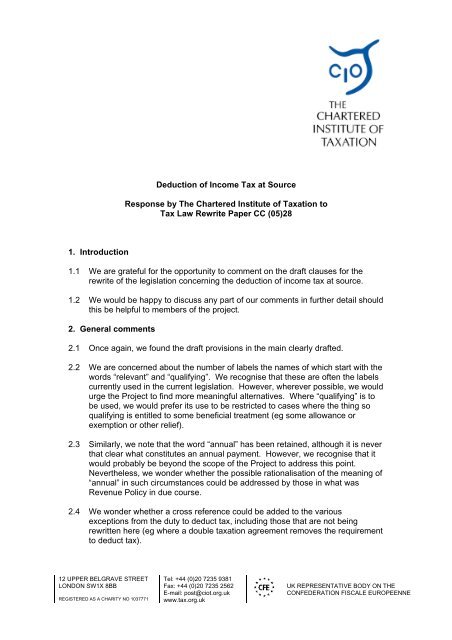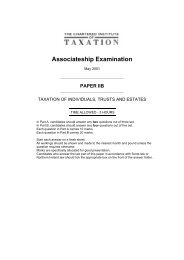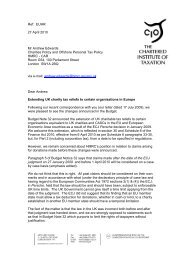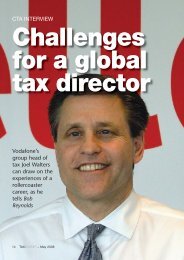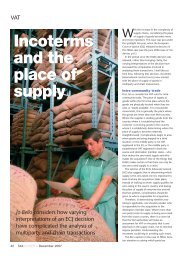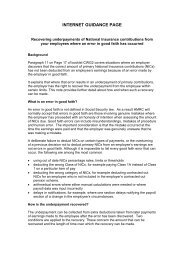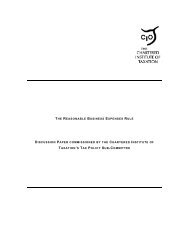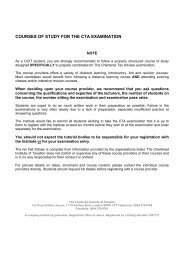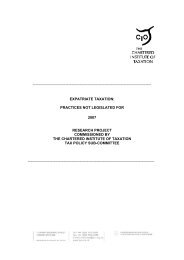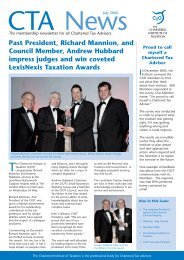Deductions at source - CIOT - The Chartered Institute of Taxation
Deductions at source - CIOT - The Chartered Institute of Taxation
Deductions at source - CIOT - The Chartered Institute of Taxation
Create successful ePaper yourself
Turn your PDF publications into a flip-book with our unique Google optimized e-Paper software.
Deduction <strong>of</strong> Income Tax <strong>at</strong> SourceResponse by <strong>The</strong> <strong>Chartered</strong> <strong>Institute</strong> <strong>of</strong> Tax<strong>at</strong>ion toTax Law Rewrite Paper CC (05)281. Introduction1.1 We are gr<strong>at</strong>eful for the opportunity to comment on the draft clauses for therewrite <strong>of</strong> the legisl<strong>at</strong>ion concerning the deduction <strong>of</strong> income tax <strong>at</strong> <strong>source</strong>.1.2 We would be happy to discuss any part <strong>of</strong> our comments in further detail shouldthis be helpful to members <strong>of</strong> the project.2. General comments2.1 Once again, we found the draft provisions in the main clearly drafted.2.2 We are concerned about the number <strong>of</strong> labels the names <strong>of</strong> which start with thewords “relevant” and “qualifying”. We recognise th<strong>at</strong> these are <strong>of</strong>ten the labelscurrently used in the current legisl<strong>at</strong>ion. However, wherever possible, we wouldurge the Project to find more meaningful altern<strong>at</strong>ives. Where “qualifying” is tobe used, we would prefer its use to be restricted to cases where the thing soqualifying is entitled to some beneficial tre<strong>at</strong>ment (eg some allowance orexemption or other relief).2.3 Similarly, we note th<strong>at</strong> the word “annual” has been retained, although it is neverth<strong>at</strong> clear wh<strong>at</strong> constitutes an annual payment. However, we recognise th<strong>at</strong> itwould probably be beyond the scope <strong>of</strong> the Project to address this point.Nevertheless, we wonder whether the possible r<strong>at</strong>ionalis<strong>at</strong>ion <strong>of</strong> the meaning <strong>of</strong>“annual” in such circumstances could be addressed by those in wh<strong>at</strong> wasRevenue Policy in due course.2.4 We wonder whether a cross reference could be added to the variousexceptions from the duty to deduct tax, including those th<strong>at</strong> are not beingrewritten here (eg where a double tax<strong>at</strong>ion agreement removes the requirementto deduct tax).12 UPPER BELGRAVE STREETLONDON SW1X 8BBREGISTERED AS A CHARITY NO 1037771Tel: +44 (0)20 7235 9381Fax: +44 (0)20 7235 2562E-mail: post@ciot.org.ukwww.tax.org.ukUK REPRESENTATIVE BODY ON THECONFEDERATION FISCALE EUROPEENNE
Tax Law Rewrite Deduction <strong>at</strong> Source <strong>CIOT</strong> comments 14 November 20053. Specific comments – Clause 23.1 We wonder if the phrase “collected through the individual’s self assessmentreturn” is quite right. It conjures up the image <strong>of</strong> cash passing through themass <strong>of</strong> paper th<strong>at</strong> constitutes a physical return. Perhaps it would be sufficientto refer to collection through the self assessment system (as suitably defined).3.2 We note th<strong>at</strong> there are differences between the rules for individuals and otherpersons. However, the wording <strong>of</strong> clauses 2 and 3 is otherwise identical(except for the reference to clause 4). For this reason we do not think th<strong>at</strong>anything is gained by repe<strong>at</strong>ing the rules for relief in successive clauses. (<strong>The</strong>rewould therefore need to be a corresponding amendment to clause 4(1).)4 Clause 34.1 Q1: We agree with the proposal to align the approach to p<strong>at</strong>ent royalties withth<strong>at</strong> for annual payments.5 Clause 75.1 Q2: We agree with the proposed terminology “sums representing income tax”.6 Part 2, Chapter 26.1 We did not consider this Chapter in detail, as the clauses were recentlyconsidered in our document d<strong>at</strong>ed 25 April 2005, and it appears th<strong>at</strong> the l<strong>at</strong>estdraft incorpor<strong>at</strong>es the amendments discussed in the subsequent responsedocument.7 Part 2, Chapter 37.1 <strong>The</strong> layout <strong>of</strong> this Chapter is not easy to follow on an initial reading. First, oneis introduced to the concept <strong>of</strong> relevant payments and those payments to whichthe Chapter does not apply. <strong>The</strong>n one encounters the duty to deduct taxfollowed by the exceptions from th<strong>at</strong> duty.7.2 For most readers <strong>of</strong> the legisl<strong>at</strong>ion, it does not m<strong>at</strong>ter whether tax is notdeductible for (1) because the payment is not relevant or (2) because there isanother exemption.7.3 It would be clearer if (where possible) the exceptions from the duty to deductcould be placed together with the provisions which exclude certain paymentsfrom the duty to deduct.8 Clause 368.1 Whilst the term “discount” does not appear in the singular form in ITTOIA, wethink th<strong>at</strong> the clause “is not discounts” in subsection (2)(b) reads r<strong>at</strong>herunn<strong>at</strong>urally. We note th<strong>at</strong> paragraph 46 <strong>of</strong> the draft Explan<strong>at</strong>ory Notes refers to“a discount”.8.2 <strong>The</strong> origin <strong>of</strong> the parenthetical words in subsection (3) is unclear.8.3 We are not convinced about the merits <strong>of</strong> retaining the expression “place <strong>of</strong>abode” – except to say th<strong>at</strong> its retention ensures th<strong>at</strong> there can be noP/bc/subsfinal/tlr 2 14.11.05
Tax Law Rewrite Deduction <strong>at</strong> Source <strong>CIOT</strong> comments 14 November 2005unintended change in the law. In particular, we can find no authority whichsuggests th<strong>at</strong> companies can be said to have an “abode”. Additionally, thereare a number <strong>of</strong> authorities which st<strong>at</strong>e th<strong>at</strong> an individual’s usual place <strong>of</strong> abodecan be th<strong>at</strong> individual’s place <strong>of</strong> business r<strong>at</strong>her than the individual’s residence.To avoid such doubts and to rid the legisl<strong>at</strong>ion <strong>of</strong> such archaic language, wewould recommend th<strong>at</strong> the terminology be upd<strong>at</strong>ed in the forthcoming FinanceBill as a pre-rewrite change.9 Clause 379.1 <strong>The</strong> heading <strong>of</strong> this and the next clause could be clearer if they explicitlyreferred to the fact th<strong>at</strong> these clauses provide exceptions from the Chapter.9.2 <strong>The</strong> same point applies to clauses 40 to 46, although these <strong>at</strong> least are coveredby an italic cross-heading which serves a similar purpose.10 Clause 3910.1 We note th<strong>at</strong> the st<strong>at</strong>ute must clearly extend who is tre<strong>at</strong>ed as the payer <strong>of</strong> theinterest (and therefore extend the scope <strong>of</strong> the duty to deduct tax). However,the expression “by or through whom” could be misleading, in th<strong>at</strong> it is followedby a requirement to deduct tax by the person “on making the payment”. Thiscondition suggests th<strong>at</strong> it is only the person who makes the payment who isobliged to deduct the tax. If so, then the words “or through whom” could bedeleted. It is clear th<strong>at</strong> this would not be appropri<strong>at</strong>e, but it would be clearer ifone could readily determine the full breadth <strong>of</strong> the duty to deduct tax.11 Clause 4011.1 Subsection (1) is not as clear as it might be. In particular, the words “is made”appear to be better placed <strong>at</strong> the end <strong>of</strong> the sentence (or a different form <strong>of</strong>words is used, eg, “if there is a relevant payment <strong>of</strong> interest to which thisChapter applies”).11.2 We welcome the clearer approach adopted by subsections (4) and (5)compared with th<strong>at</strong> in section 349(3AB). However, we wonder if subsection (5)could be simplified further by:• omitting the words “to deduct a sum representing income tax under section39” and “to a payment <strong>of</strong> interest on an advance from th<strong>at</strong> organis<strong>at</strong>ion”; and• replacing the final words by “even if the condition in subsection (2) is notmet”.12 Clause 4112.1 It would be <strong>of</strong> immense benefit to readers <strong>of</strong> this clause to have a signpost tothe provisions th<strong>at</strong> do require banks to deduct tax.13 Clause 4613.1 We wonder whether it would be appropri<strong>at</strong>e to include section 486(9) within theorigins for subsection (1) as well as subsection (3).13.2 We note th<strong>at</strong> subsection (2) might contravene EC law.P/bc/subsfinal/tlr 3 14.11.05
Tax Law Rewrite Deduction <strong>at</strong> Source <strong>CIOT</strong> comments 14 November 200513.3 We repe<strong>at</strong> our previous comments concerning the phrase “place <strong>of</strong> abode”.14 Clause 4714.1 Q3: We welcome the clarific<strong>at</strong>ion, but think it would be better placed closer tothe definition <strong>of</strong> “relevant payment <strong>of</strong> yearly interest” r<strong>at</strong>her than left as anorphan provision.15 Clause 4815.1 Q4: We see no need for the inclusion <strong>of</strong> clause 48(3)(b).15.2 Q5: If the Building Societies do not need to rely upon this explicit exemption forqualifying deposit rights, then it would be better to remove such references.16 Clause 4916.1 Q6: We welcome this clarific<strong>at</strong>ion, but think th<strong>at</strong> the Explan<strong>at</strong>ory Notes wouldbenefit by the addition <strong>of</strong> a paragraph explaining why this is not a change(referring perhaps to the current practice and any comments <strong>of</strong> the BSA).16.2 We note th<strong>at</strong> the origins <strong>of</strong> this clause are not shown <strong>at</strong> all.17 Clause 5317.1 This clause is a vast improvement on ICTA section 50(3).17.2 Q7: We welcome the label “gross-paying government securities”. Whilst ithardly trips <strong>of</strong>f the tongue, it does have the advantage <strong>of</strong> “doing wh<strong>at</strong> it says inthe tin”.17.3 Q8: We agree th<strong>at</strong> the parenthetical words in ICTA section 50(A1) add nothingand can be safely removed.18 Clause 5418.1 We welcome the omission <strong>of</strong> the words currently in ICTA section 51(2) “for thepurposes <strong>of</strong> making issues from the Consolid<strong>at</strong>ed Fund <strong>of</strong> Northern Ireland”.18.2 <strong>The</strong> modific<strong>at</strong>ions made by subsection (4) would be more logically placed insection 55 (where one has to ensure th<strong>at</strong> there is no modific<strong>at</strong>ion <strong>of</strong> themeaning <strong>of</strong> “<strong>The</strong> Treasury” as used by clause 54).18.3 Additionally, the words “those section” in paragraph (b) require an additional “s”.19 Clause 5519.1 We note th<strong>at</strong> the current legisl<strong>at</strong>ion refers to an “applic<strong>at</strong>ion”. Whilst we do notobject to this term, we wonder whether it is more akin to an “election” ins<strong>of</strong>ar asthe Registrar has no discretion to refuse any applic<strong>at</strong>ion validly made.However, we note th<strong>at</strong> to change the wording might lead to difficulties with theTMA provisions concerning the making (and revoking) <strong>of</strong> elections.P/bc/subsfinal/tlr 4 14.11.05
Tax Law Rewrite Deduction <strong>at</strong> Source <strong>CIOT</strong> comments 14 November 200520 Clause 5720.1 <strong>The</strong> references in subsections (1), (2)(c) and (4) to Her Majesty use lower-caseaitches.21 Clause 5921.1 We share the concern raised <strong>at</strong> the Consult<strong>at</strong>ive Committee meeting inSeptember 2005 th<strong>at</strong> the phrase “arises in the UK” is meaningless (or, <strong>at</strong> best,unclear) in the context <strong>of</strong> a payment. We note th<strong>at</strong> terminology is used,however, in section 347A(2A)(a) (as inserted by ITTOIA). Nevertheless, theExplan<strong>at</strong>ory Notes explain more clearly wh<strong>at</strong> is meant by the clause – th<strong>at</strong> thepayment has a UK <strong>source</strong>.21.2 It would be useful if the Explan<strong>at</strong>ory Notes made an explicit reference to theprovisions in Chapter 10 dealing with unauthorised unit trusts.22 Clause 6022.1 Q9: We welcome the simplific<strong>at</strong>ion proposed by the transfer <strong>of</strong> the collectionmechanism to Self Assessment.23 Clause 6123.1 We feel th<strong>at</strong> it would be just as easy (and clearer for readers) if the closingwords <strong>of</strong> subsection (2) repe<strong>at</strong>ed the wording <strong>of</strong> clause 60(1)(c) r<strong>at</strong>her thanmerely referred to it.23.2 We would also prefer all the conditions within th<strong>at</strong> subsection to be included inone list. Currently, the subsection reads: If X then Y only if Z. It would beclearer if it were <strong>of</strong> the form, Not Y if (X and Not Z).23.3 We would prefer subsection (4) to be split across two subsections.24 Clause 6224.1 Whilst we are not keen on the use <strong>of</strong> assumptions, etc, we wonder whether thewords “were it not for the person whose income it is” would be better replacedby the less opaque “if it were received by an individual”.25 Clause 6325.1 <strong>The</strong> provisions referred to in the origins shown under subsection (4) do notappear to include any reference to corpor<strong>at</strong>ion tax.25.2 We also note th<strong>at</strong> the conditions in subsections (2) to (4) are not labelled assuch. We wonder whether this is an oversight or whether there are differenttypes <strong>of</strong> conditions – those th<strong>at</strong> are labelled A, B, C etc and those th<strong>at</strong> are not.26 Clause 6426.1 <strong>The</strong> origins to subsection (1) refer to ICTA, s349(7) and the provision in FA2004, which inserted s349(7). Section 349(7) was, however, substituted byITTOIA.P/bc/subsfinal/tlr 5 14.11.05
Tax Law Rewrite Deduction <strong>at</strong> Source <strong>CIOT</strong> comments 14 November 200526.2 Furthermore, subsection (1) appears to suggest th<strong>at</strong> the exemption conferredby Chapter 10 <strong>of</strong> Part 6 <strong>of</strong> ITTOIA does not cover the requirement to deduct taxunder wh<strong>at</strong> is currently ICTA s349. This is on the basis th<strong>at</strong> the clause st<strong>at</strong>esth<strong>at</strong> the payment is not to be ignored for the purposes <strong>of</strong> the duty to deduct.However, Chapter 10 provides th<strong>at</strong> exempt income is to be ignored for allother income tax purposes except where there is an implied or expressprovision to the contrary. In our view, there is no such implied or expressprovision to the contrary. Instead, wh<strong>at</strong> FA 2004 s101 provides is th<strong>at</strong> therecan be a temporary exemption when the income is thought to be exempt.However, under the FA 2004 régime (as extended by ITTOIA), exempt incomeis exempt from deduction. <strong>The</strong>refore, truly exempt income can be ignored forthe purposes <strong>of</strong> the duty under clause 63.27 Clause 6727.1 We repe<strong>at</strong> our previous comments concerning the phrase “place <strong>of</strong> abode”.28 Clause 6828.1 We repe<strong>at</strong> our previous comments concerning the scope <strong>of</strong> FA 2004 s101.29 Clause 6929.1 Subsections (3) to (5) (and, in particular, the last two) should be hived <strong>of</strong>f to asepar<strong>at</strong>e clause as they go far beyond situ<strong>at</strong>ions involving agents.30 Clause 7030.1 We wonder whether the omission <strong>of</strong> the reference to ITTOIA s599 would beworthy <strong>of</strong> a mention in the Explan<strong>at</strong>ory Notes. Or should th<strong>at</strong> section in fact bereferred to in subsection (4)?31 Clause 7131.1 After dealing with Chapter 6 and the preceding clauses <strong>of</strong> Chapter 7, all <strong>of</strong>which deal with intellectual property rights, clause 71 stands out like a sorethumb in th<strong>at</strong> it deals with non-commercial payments by companies. This ismade worse when one realises th<strong>at</strong> the next clause (clause 72) is the beginning<strong>of</strong> Chapter 8, which also deals with royalty payments.31.2 Under the current layout <strong>of</strong> chapters this is perhaps inevitable (although thesitu<strong>at</strong>ion could be slightly amelior<strong>at</strong>ed by moving this clause to the top <strong>of</strong> theChapter so th<strong>at</strong> it does not get lost after all the IP provisions).31.3 An altern<strong>at</strong>ive approach would be to hive <strong>of</strong>f clause 71 into a Chapter <strong>of</strong> its own(a single-clause Chapter would not be new), leaving the rest <strong>of</strong> Chapter 7 andfor Chapter 8 to deal with the sundry IP provisions.32 Clause 7332.1 Q10: We agree it is appropri<strong>at</strong>e to refer to an <strong>of</strong>ficer <strong>of</strong> R&C in this situ<strong>at</strong>ion.P/bc/subsfinal/tlr 6 14.11.05
Tax Law Rewrite Deduction <strong>at</strong> Source <strong>CIOT</strong> comments 14 November 200533 Clause 7433.1 We note th<strong>at</strong> the inclusive definition <strong>of</strong> “royalty” has seen an “or” change to an“and”. However, we agree th<strong>at</strong> this makes no m<strong>at</strong>erial difference to themeaning <strong>of</strong> the law – but makes the definition clearer.34 Clause 7934.1 Initially, we were tempted to agree with the Project in its decision to includeclause 79 in Bill 4. This was the case even though it makes modific<strong>at</strong>ions toother provisions.34.2 However, on reflection, this drafting technique is not strictly necessary.Consequently, the legisl<strong>at</strong>ion would be clearer if:• a new para 3(5) (say) were added to FA 1998 Schedule 18;• a new paragraph 20A were inserted after para 20 (with para 20 suitablymodified) to deal with these penalties; and• clause 79 merely provided a helpful cross-reference to Schedule 18 asappropri<strong>at</strong>e.35 Clause 8135.1 In subsection (1), we wonder if “none … apply” should be “none … applies”.35.2 As subsection (3) qualifies subsection (1) and subsection (4) qualifiessubsection (2), we wonder if (2) and (3) could be swapped around.35.3 Subsection (5), like existing section 349A(5), does not explain explicitly wh<strong>at</strong>happens if the principal is another company. In other words, does theexemption apply if a company makes a qualifying payment on behalf <strong>of</strong> anothercompany? <strong>The</strong> Explan<strong>at</strong>ory Notes suggest th<strong>at</strong> there is no exemption in suchcases, but this is not obvious from the clause. We would recommend th<strong>at</strong> thisbe made more explicit. We suggest th<strong>at</strong> subsection (5) be varied to:Subsection (1) does not apply to any payment made by a companyacting as a trustee or agent for another person.35.4 Would it be possible to add “qualifying partnerships” to the list <strong>of</strong> payers insubsection (1)(a) and replace subsection (6) by a definition <strong>of</strong> qualifyingpartnership? Clauses 81(5), 82(5) and 88 would need to be amendedaccordingly.36 Clause 8336.1 No doubt, this clause (when compared with clause 84) risks a future challengeunder European law. A similar comment applies in respect <strong>of</strong> clause 87(4) and(5).P/bc/subsfinal/tlr 7 14.11.05
Tax Law Rewrite Deduction <strong>at</strong> Source <strong>CIOT</strong> comments 14 November 200537 Clause 8537.1 We wonder if the various permut<strong>at</strong>ions <strong>of</strong> subsection (2) could be set out moreclearly, perhaps even splitting it back into the two paragraphs as under thecurrent legisl<strong>at</strong>ion.38 Clause 8838.1 Despite the subsequent reference to “subsection (2)”, as a m<strong>at</strong>ter <strong>of</strong> draftingstyle, we would prefer the reference to subsection (1) to be in the form “section81(1)”. This is a more concise style <strong>of</strong> drafting and allows readers to see morereadily which section is being referred to.38.2 We repe<strong>at</strong> our comments rel<strong>at</strong>ing to the possible inclusion <strong>of</strong> a term “qualifyingpartnership”.39 Chapter 1039.1 Q11: We understand the reasoning behind the deeming. However, we are notsure th<strong>at</strong> it is necessary to adopt this approach. This is because it amounts tothe deemed deduction from a deemed payment, and the Rewrite Project hasalways striven to reduce the incidence <strong>of</strong> st<strong>at</strong>utory deeming.39.2 As far as the unit holders are concerned, the tax tre<strong>at</strong>ment is akin to dividendsin th<strong>at</strong> there is some income arising (albeit a deemed distribution in UUT cases)to which there is <strong>at</strong>tached a credit. <strong>The</strong>re seems to be no reason to deem anydeduction to have been made.39.3 As far as the trustees are concerned, the amount <strong>of</strong> the “deemed deduction” ismore significant as it impacts upon the tax payable by them. However, we aresure th<strong>at</strong> the same result can be achieved more directly.39.4 Once one moves away from the deemed deduction approach, it might transpireth<strong>at</strong> the remaining provisions <strong>of</strong> Chapter 10 are better suited in another Part <strong>of</strong>the Bill altogether. This would give rise to a consequential amendment toclause 112(3), (4) and (6).40 Clause 9040.1 Q12: We do not object to the alignment <strong>of</strong> the law with the current practicewhich requires UUTs to account for the tax due under the SA provisions.41 Clause 9141.1 We are not sure th<strong>at</strong> the steps in subsection (2) actually determine whetherthere is a useable excess from earlier years. Presumably, there is no suchexcess if the amount determined by the steps is nil or neg<strong>at</strong>ive (as suggestedby paragraph 260 <strong>of</strong> the Explan<strong>at</strong>ory Notes). However, this should be madeexplicit in the legisl<strong>at</strong>ion.42 Part 2, Chapter 1142.1 We did not consider this Chapter in detail as the clauses were recentlyconsidered in our document d<strong>at</strong>ed 12 July 2005. We note, however, th<strong>at</strong> theP/bc/subsfinal/tlr 8 14.11.05
Tax Law Rewrite Deduction <strong>at</strong> Source <strong>CIOT</strong> comments 14 November 2005l<strong>at</strong>est draft Chapter incorpor<strong>at</strong>es the amendments discussed in the recentresponse document.43 Clause 11043.1 Q13: We welcome the decision to remove the section 350 “charge” to tax.44 Clause 11244.1 We have earlier suggested th<strong>at</strong> subsections (3) and (4) might be removed if theapproach to UUTs is revised. However, for the purposes <strong>of</strong> the followingcomment, we assume th<strong>at</strong> they are to be retained in this clause. <strong>The</strong> openingwords <strong>of</strong> both subsections (1) and (3) provide th<strong>at</strong> the clause applies if certainconditions are fulfilled. Logically, if the conditions in subsection (3) are fulfilled,then the whole <strong>of</strong> the clause applies (including subsection (2)). Similarly,subsection (4) applies (from a logical perspective) if subsection (1) is s<strong>at</strong>isfied.However, the apparent intention <strong>of</strong> the provisions is th<strong>at</strong>:• subsection (2) applies if and only if the conditions <strong>of</strong> (1) are s<strong>at</strong>isfied;and• subsection (4) applies if and only if the conditions <strong>of</strong> (3) are s<strong>at</strong>isfied.44.2 We would prefer subsection (7) to be worded along the lines, “the definitions insection 89(7) apply to this section”.45 Clause 11345.1 We wonder whether subsection (2) could be omitted and replaced by theinsertion <strong>of</strong> “beneficial” before “recipient” in subsection (1).46 Clause 11646.1 Q14: We do not object to the proposal to extend the applic<strong>at</strong>ion <strong>of</strong> the definition<strong>of</strong> “deposit”.47 Clause 11747.1 <strong>The</strong> relevance <strong>of</strong> the words “, or financial instruments,” is unclear in subsection(1)(c). We note th<strong>at</strong> it replic<strong>at</strong>es the existing provision in section 349(5).Gramm<strong>at</strong>ically, it appears to provide an altern<strong>at</strong>ive to the preceding words “afinancial instrument”. However, if th<strong>at</strong> were the case, would th<strong>at</strong> not be coveredby section 6(c) <strong>of</strong> the Interpret<strong>at</strong>ion Act 1978? If the m<strong>at</strong>ter is to be put beyonddoubt, we would suggest a separ<strong>at</strong>e subsection to th<strong>at</strong> effect.48 Clause 11848.1 Q15: We are not convinced th<strong>at</strong> this does not represent a change in the law.ITTOIA section 552 is based on ICTA section 56(5). Th<strong>at</strong> refers to “anoblig<strong>at</strong>ion to pay a st<strong>at</strong>ed amount”. However, section 6(c) <strong>of</strong> the Interpret<strong>at</strong>ionAct seems to allow th<strong>at</strong> to be read as “an oblig<strong>at</strong>ion to pay st<strong>at</strong>ed amounts” andalso “oblig<strong>at</strong>ions to pay st<strong>at</strong>ed amounts”. But, there again, it seems equallyvalid to interpret the rewritten provisions in similar ways so as to allow there tobe more than one repayment d<strong>at</strong>e.P/bc/subsfinal/tlr 9 14.11.05
Tax Law Rewrite Deduction <strong>at</strong> Source <strong>CIOT</strong> comments 14 November 200549 Clause 11949.1 Q16: We are not convinced th<strong>at</strong> this does not represent a change in the law.ITTOIA, section 552 is based on ICTA, section 56(5). Th<strong>at</strong> refers to “anoblig<strong>at</strong>ion to pay a st<strong>at</strong>ed amount”. However, section 6(c) <strong>of</strong> the Interpret<strong>at</strong>ionAct seems to allow th<strong>at</strong> to be read as “an oblig<strong>at</strong>ion to pay st<strong>at</strong>ed amounts” andalso “oblig<strong>at</strong>ions to pay st<strong>at</strong>ed amounts”. But, there again, it seems equallyvalid to interpret the rewritten provisions in similar ways so as to allow there tobe more than one repayment d<strong>at</strong>e.49.2 Q17: If here is no practical need for the reference to units, then we have noobjection to their being omitted.50 Clause 12050.1 Q18: In the context <strong>of</strong> the current drafts, the single definition <strong>of</strong> “quotedEurobond” seems appropri<strong>at</strong>e.<strong>The</strong> <strong>Chartered</strong> <strong>Institute</strong> <strong>of</strong> Tax<strong>at</strong>ion14 November 2005P/bc/subsfinal/tlr 10 14.11.05


